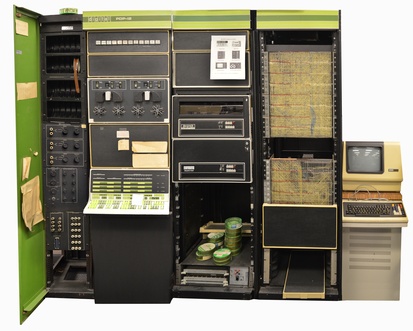PDP-12
The PDP-12 is a dual-processor 12-bit minicomputer designed for interactive, real-time laboratory use. It was introduced in 1969 and 725 were built before the line was discontinued in 1972. The basic machine came configured with dual LINCtape drives, a scope display and IO ports for interfacing with external laboratory equipment.
It can run a number of different operating systems, including DIALPS, LAP6W and OS/8.
Although you can program the PDP-12 from the front panel, it was normally used with a terminal attached for user interaction. Typically this would have been an ASR33 Teletype, but it could be any current loop or RS232 device.
Some software for the LINC line used the display scope on the PDP-12 for display and only the input from the terminal keyboard.
Unlike most tape drives, LINCtape are random access read/write, so you can have a filesystem on tape and use it interactively like a disk.
The PDP-12 has special instructions for dealing with real world devices, since it was designed for lab use. Sampling an analogue input channel and putting the results in the accumulator is one instruction. Setting the relays is one instruction. Displaying a point on the scope is one instruction. The external IO ports include eight analog input ports connected to 1/4" jacks, six digital outputs connected to mechanical relays and a connector for an oscilloscope.
There are eight analog input ports connected to dials and a speaker connected to the high bit of the accumulator. There are also frequency triggers.
The PDP-12 has an awe-inspiring front panel. Two sets of twelve switches allow you to set address and data separately for toggling in code or for controlling a running program. Single instructions give access to either set of switches.

